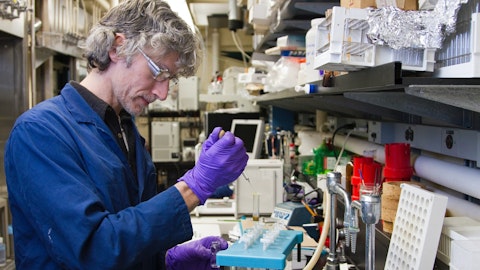Nick Green: Thank you, Matt.
Operator: Thank you. Our next question comes from the line of Jacob Johnson of Stephens. Your question, please, Jacob.
Jacob Johnson: Hey, thanks. Will say congrats on a nice quarter and nice backlog. Maybe first for Nick or for Matt, I am just curious on the new business development addition to go after large pharma. I’m curious about the strategy there. I mean I think probably unfairly, people might not think smaller CDMO like Avid would work with larger pharma, again, probably unfair. But if you could just maybe touch on the strategy there, and I assume large pharma, probably they don’t just work on blockbuster drugs, and so there is pretty plenty of things you could handle, but I figure I’d give you the forum to chat about that?
Nick Green: Yes. Thanks, Jacob. Just you broke up in the middle of that, unfortunately. So just let me just clarify, you’re asking about big pharma and why they are looking at Avid, I am correct or?
Jacob Johnson: Yes. I apologize if I broke up. But yes, I’m just kind of curious about the strategy going after large pharma and where Avid can help out large pharma customers, in case? And I think it’s something investors might not think of when they think about it, yes.
Nick Green: No, absolutely. Good question. So no, I mean, I think what Avid has done over the last few years, obviously, we spent a significant amount of capital on enhancing our capabilities, but also our capacity. I actually love walking around the new facility now and even though they won’t let me in anymore, because it’s all tied up and buttoned up ready for manufacturing. But we can look through the windows. It really is a fantastic facility and views very well. We’ve supported that with the process development capability and capacity, again, so it’s really a very strong value proposition to big pharma. And if you look at molecules today, I was only reading an article the other day looking at the number of molecules that will be sub 100 kilos of protein going forward that are currently in Phase 3.
And there is a significant number of those and some of those exist in big pharma. So it’s not always about blockbusters. There is orphan drugs and smaller populations and the like. And I think, frankly, that’s where the industry is heading as we’ve obviously cured a lot of the big blockbuster disease states, then obviously, we have to focus on the smaller disease states, and as the drugs become better and more targeted and more therapeutic than obviously, the scale of the reactors comes down, and then you’ve got the manufacturing yields that go up on top of that as well. So reduced indications, increase yields means that the 2,000 liter platform becomes ever more relevant for both emerging and big pharma and can be a commercially viable platform to launch from.
And even if you’ve got a larger molecule in your maybe a smaller or medium-sized pharma, do you really want to go out and bet everything on going out and qualifying it at very large scale as opposed to maybe getting your process qualified succeeding with the BLA and then moving on and maybe adding a second supplier, who has larger capacity at a later stage. So it’s the offering is across the board to small, medium and large pharma today, I believe.
Jacob Johnson: Got it. Thanks for that. And then maybe just one for Dan, I appreciate kind of the outline of the CapEx left on the expansion projects. Maybe just if you touch on kind of two dynamics as it relates to cash flow. Just now that this capacity is €“ a lot of this capacity is online and you start running revenue through it and getting the margin on that along with the additional capacity investments you’re making in the next couple of quarters, if you just talk about the outlook for cash flow in the near-term and maybe beyond as well?
Dan Hart: Sure. Thanks for the question, Jacob. As I outlined in the prepared remarks and within the filings today, the estimated capital spend for this fiscal year is going to be roughly $90 million through the third quarter, we had cash expenditures of $53 million, and we had incurred $24 million, which that will flow through our fourth quarter here. Looking ahead, there is an additional roughly $25 million, $27 million left of capital to be spent to close out all of the facilities and those facilities, some of that cash lingers passed once those get commissioned as things get closed out. But looking forward, we firmly believe that the existing cash and cash equivalents on hand and the cash from operations going forward sufficient to fund the operations.
Jacob Johnson: Got it. Thanks for that, Dan. Appreciate it.
Operator: Thank you. Our next question comes from the line of Paul Knight of KeyBanc. Your question, please, Paul.
Paul Knight: Yes. Matt, could you talk to that earlier statement you made about new customer signings are one-half of what backlog built over the last 12 months, was that the comment?
Matt Kwietniak: No, it was new client signings in the period was equal to half of the prior year. Not about new clients.
Paul Knight: Got it. The other question, Nick, as you mentioned earlier in your call about $400 million capacity seems a touch higher than in the past. Are you seeing better yields, anything behind that $400 million potential?
Nick Green: Yes. I mean I’d draw your attention first and foremost, I guess, to process development. We’ve always kind of said that PD was $20 million capacity, but they have already done $18 million year-to-date. So clearly, they are doing better than that. So €“ and we’ve seen something similar in the other areas of the mammalian capacity that would suggest that it’s certainly 400-plus today. So it’s really the throughput that we’re actually getting. Again, I wish that it was a perfect science, sometimes it’s product mix, sometimes it’s process efficiency. So it can vary, and there is always a little bit of an element of judgment. But I think it’s €“ I feel €“ well, certainly, we wouldn’t be saying it if we didn’t feel very confident that it was $400 million plus.
Paul Knight: And then last question, Nick, would be we see the capacity announcements from Lonza, from Catalent, from WuXi, etcetera. And with this capacity going on, yet your success at building backlog, what do you think people are liking about Avid relative to what others are as well doing in terms of capacity?





